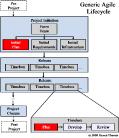I ran a massed prototyping exercise with my current team. The whole team: development, user experience and design, testing, product management, business analysis, programme/project management and the programme director. It was a concerted effort to get a solution covering everything. The idea was to build wide not deep. The requirements for the end to end workflow was a generic operating model we’d developed previously. Microsoft Sharepoint was the underlying platform so this exercise concentrated on “out-of-the-box” solutions based on Sharepoint.
Expected Benefits
I allocated a week for this so the cost was quite high. On the other hand I expected considerable benefits. I expected “Build it in a Week” to enable us to:
- understand the requirements more
- validate the generic operating model
- validate the emerging information architecture
- identify technical challenges and identify if “tricky” things were in fact simple
- demo an end to end solution (even if clunky and with caveats)
- understand Sharepoint 2010 more, specifically understand what “out-of-the-box” means in 2010
- identify what we can’t do “out-of-the-box” right now
- understand each other more
As programme manager I thought it worth the cost.
Continue reading
